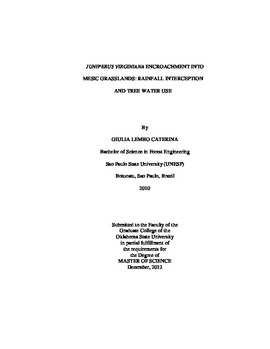| dc.contributor.advisor | Turton, Donald | |
| dc.contributor.author | Caterina, Giulia Lembo | |
| dc.date.accessioned | 2014-04-15T21:59:37Z | |
| dc.date.available | 2014-04-15T21:59:37Z | |
| dc.date.issued | 2012-12-01 | |
| dc.identifier.uri | https://hdl.handle.net/11244/9160 | |
| dc.description.abstract | Juniperus virginiana is encroaching into the Great Plains of the United States at an alarming rate causing ecological and economic harm. Juniperus virginiana expansion alters the species diversity, soil properties, and water balance. Determining how J. virginiana changes tallgrass prairies water balance is extremely important to maintain the ecosystem services of these ecosystems. The objectives of this study were to quantify and evaluate which factors affect J. virgniana canopy interception and water use. Twenty five trees of different diameters from both closed and open grown stands were used. To quantify canopy interception, throughfall and stemflow were measured for each tree during 47 rainfall events. We measured tree water use during the 2011 calendar year using the thermal dissipation technique described by Granier. Environmental factors were measured at the site to determine their effects on canopy interception and water use. Both experiments were performed in encroached tallgrass prairie watersheds near Stillwater, OK. Juniperus virginiana canopies intercepted an average of 37% of the total rainfall during the study period. Small rainfall events were almost totally held by J. virginiana canopies. Around 20% of the precipitation from the largest events of high intensity were intercepted by the canopy. Stemflow averaged 7% of rainfall for all trees. Throughfall was mainly explained by three storm characteristics: rainfall amount, intensity and duration. Tree characteristics, rainfall amount and duration were the main factors influencing stemflow. All J. virginiana trees used water year-round. Average daily water use ranged from 2 liters to 80 liters, for trees of 2 and 31 cm DBH, respectively. The maximum daily water use was 152 liters for a 31 cm DBH open grown tree. Water use fluctuation was mainly explained by daily potential evapotranspiration, vapor pressure deficit, maximum temperature, solar radiation, and volumetric soil water content between 0-10cm. Results from both experiments will later be used to scale J. virginiana canopy interception and water uptake to whole watersheds. | |
| dc.format | application/pdf | |
| dc.language | en_US | |
| dc.publisher | Oklahoma State University | |
| dc.rights | Copyright is held by the author who has granted the Oklahoma State University Library the non-exclusive right to share this material in its institutional repository. Contact Digital Library Services at lib-dls@okstate.edu or 405-744-9161 for the permission policy on the use, reproduction or distribution of this material. | |
| dc.title | Juniperus Virginiana Encroachment into Mesic Grasslands: Rainfall Interception and Tree Water Use | |
| dc.type | text | |
| dc.contributor.committeeMember | Zou, Chris B. | |
| dc.contributor.committeeMember | Will, Rod | |
| osu.filename | Caterina_okstate_0664M_12587.pdf | |
| osu.college | Agricultural Sciences and Natural Resources | |
| osu.accesstype | Open Access | |
| dc.description.department | Department of Natural Resource Ecology and Management | |
| dc.type.genre | Thesis | |
| dc.subject.keywords | eastern redcedar | |
| dc.subject.keywords | rainfall interception | |
| dc.subject.keywords | water use | |
